MARKETING
24 of My Favorite Sample Business Plans & Examples For Your Inspiration

I believe that reading sample business plans is essential when writing your own.
As you explore business plan examples from real companies and brands, it’s easier for you to learn how to write a good one.
But what does a good business plan look like? And how do you write one that’s both viable and convincing. I’ll walk you through the ideal business plan format along with some examples to help you get started.
Table of Contents
Business Plan Format
Ask any successful sports coach how they win so many games, and they’ll tell you they have a unique plan for every single game. To me, the same logic applies to business.
If you want to build a thriving company that can pull ahead of the competition, you need to prepare for battle before breaking into a market.
Business plans guide you along the rocky journey of growing a company. And if your business plan is compelling enough, it can also convince investors to give you funding.
With so much at stake, I’m sure you’re wondering where to begin.
First, you’ll want to nail down your formatting. Most business plans include the following sections.
1. Executive Summary
I’d say the executive summary is the most important section of the entire business plan.
Why? Essentially, it’s the overview or introduction, written in a way to grab readers’ attention and guide them through the rest of the business plan. This is important, because a business plan can be dozens or hundreds of pages long.
There are two main elements I’d recommend including in your executive summary:
Company Description
This is the perfect space to highlight your company’s mission statement and goals, a brief overview of your history and leadership, and your top accomplishments as a business.
Tell potential investors who you are and why what you do matters. Naturally, they’re going to want to know who they’re getting into business with up front, and this is a great opportunity to showcase your impact.
Need some extra help firming up those business goals? Check out HubSpot Academy’s free course to help you set goals that matter — I’d highly recommend it
Products and Services
To piggyback off of the company description, be sure to incorporate an overview of your offerings. This doesn’t have to be extensive — just another chance to introduce your industry and overall purpose as a business.
In addition to the items above, I recommend including some information about your financial projections and competitive advantage here too.:
Keep in mind you’ll cover many of these topics in more detail later on in the business plan. So, keep the executive summary clear and brief, and only include the most important takeaways.
Executive Summary Business Plan Examples
This example was created with HubSpot’s business plan template:
This executive summary is so good to me because it tells potential investors a short story while still covering all of the most important details.
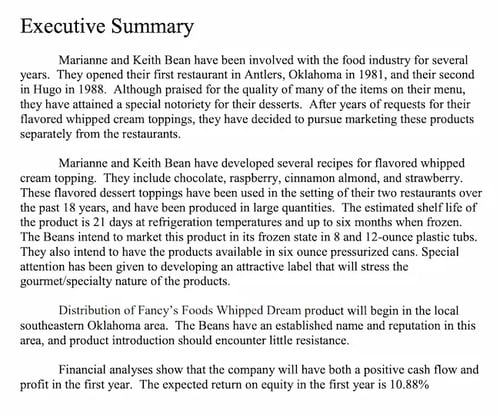
Tips for Writing Your Executive Summary
- Start with a strong introduction of your company, showcase your mission and impact, and outline the products and services you provide.
- Clearly define a problem, and explain how your product solves that problem, and show why the market needs your business.
- Be sure to highlight your value proposition, market opportunity, and growth potential.
- Keep it concise and support ideas with data.
- Customize your summary to your audience. For example, emphasize finances and return on investment for venture capitalists.
Check out our tips for writing an effective executive summary for more guidance.
2. Market Opportunity
This is where you’ll detail the opportunity in the market.
The main question I’d ask myself here is this: Where is the gap in the current industry, and how will my product fill that gap?
More specifically, here’s what I’d include in this section:
- The size of the market
- Current or potential market share
- Trends in the industry and consumer behavior
- Where the gap is
- What caused the gap
- How you intend to fill it
To get a thorough understanding of the market opportunity, you’ll want to conduct a TAM, SAM, and SOM analysis and perform market research on your industry.
You may also benefit from creating a SWOT analysis to get some of the insights for this section.
Market Opportunity Business Plan Example
I like this example because it uses critical data to underline the size of the potential market and what part of that market this service hopes to capture.

Tips for Writing Your Market Opportunity Section
- Focus on demand and potential for growth.
- Use market research, surveys, and industry trend data to support your market forecast and projections.
- Add a review of regulation shifts, tech advances, and consumer behavior changes.
- Refer to reliable sources.
- Showcase how your business can make the most of this opportunity.
3. Competitive Landscape
Since we’re already speaking of market share, you’ll also need to create a section that shares details on who the top competitors are.
After all, your customers likely have more than one brand to choose from, and you’ll want to understand exactly why they might choose one over another.
My favorite part of performing a competitive analysis is that it can help you uncover:
- Industry trends that other brands may not be utilizing
- Strengths in your competition that may be obstacles to handle
- Weaknesses in your competition that may help you develop selling points
- The unique proposition you bring to the market that may resonate with customers
Competitive Landscape Business Plan Example
I like how the competitive landscape section of this business plan below shows a clear outline of who the top competitors are.

It also highlights specific industry knowledge and the importance of location, which shows useful experience in this specific industry.
This can help build trust in your ability to execute your business plan.
Tips for Writing Your Competitive Landscape
- Complete in-depth research, then emphasize your most important findings.
- Compare your unique selling proposition (USP) to your direct and indirect competitors.
- Show a clear and realistic plan for product and brand differentiation.
- Look for specific advantages and barriers in the competitive landscape. Then, highlight how that information could impact your business.
- Outline growth opportunities from a competitive perspective.
- Add customer feedback and insights to support your competitive analysis.
4. Target Audience
Use this section to describe who your customer segments are in detail. What is the demographic and psychographic information of your audience?
If your immediate answer is “everyone,” you’ll need to dig deeper. Here are some questions I’d ask myself here:
- What demographics will most likely need/buy your product or service?
- What are the psychographics of this audience? (Desires, triggering events, etc.)
- Why are your offerings valuable to them?
I’d also recommend building a buyer persona to get in the mindset of your ideal customers and be clear on why you’re targeting them.
Target Audience Business Plan Example
I like the example below because it uses in-depth research to draw conclusions about audience priorities. It also analyzes how to create the right content for this audience.

Tips for Writing Your Target Audience Section
- Include details on the size and growth potential of your target audience.
- Figure out and refine the pain points for your target audience, then show why your product is a useful solution.
- Describe your targeted customer acquisition strategy in detail.
- Share anticipated challenges your business may face in acquiring customers and how you plan to address them.
- Add case studies, testimonials, and other data to support your target audience ideas.
- Remember to consider niche audiences and segments of your target audience in your business plan.
5. Marketing Strategy
Here, you’ll discuss how you’ll acquire new customers with your marketing strategy. I’d suggest including information:
- Your brand positioning vision and how you’ll cultivate it
- The goal targets you aim to achieve
- The metrics you’ll use to measure success
- The channels and distribution tactics you’ll use
I think it’s helpful to have a marketing plan built out in advance to make this part of your business plan easier.
Marketing Strategy Business Plan Example
This business plan example includes the marketing strategy for the town of Gawler.
In my opinion, it really works because it offers a comprehensive picture of how they plan to use digital marketing to promote the community.
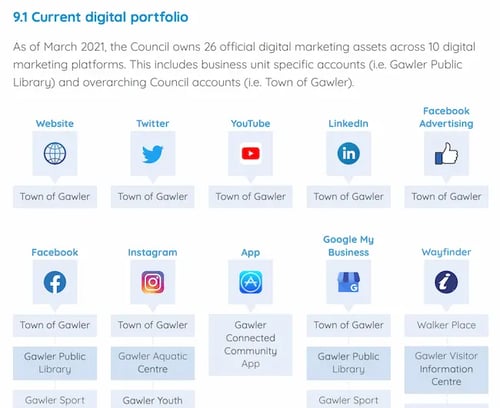
Tips for Writing Your Marketing Strategy
- Include a section about how you believe your brand vision will appeal to customers.
- Add the budget and resources you’ll need to put your plan in place.
- Outline strategies for specific marketing segments.
- Connect strategies to earlier sections like target audience and competitive analysis.
- Review how your marketing strategy will scale with the growth of your business.
- Cover a range of channels and tactics to highlight your ability to adapt your plan in the face of change.
6. Key Features and Benefits
At some point in your business plan, you’ll need to review the key features and benefits of your products and/or services.
Laying these out can give readers an idea of how you’re positioning yourself in the market and the messaging you’re likely to use. It can even help them gain better insight into your business model.
Key Features and Benefits Business Plan Example
In my opinion, the example below does a great job outlining products and services for this business, along with why these qualities will attract the audience.

Tips for Writing Your Key Features and Benefits
- Emphasize why and how your product or service offers value to customers.
- Use metrics and testimonials to support the ideas in this section.
- Talk about how your products and services have the potential to scale.
- Think about including a product roadmap.
- Focus on customer needs, and how the features and benefits you are sharing meet those needs.
- Offer proof of concept for your ideas, like case studies or pilot program feedback.
- Proofread this section carefully, and remove any jargon or complex language.
7. Pricing and Revenue
This is where you’ll discuss your cost structure and various revenue streams. Your pricing strategy must be solid enough to turn a profit while staying competitive in the industry.
For this reason, here’s what I’d might outline in this section:
- The specific pricing breakdowns per product or service
- Why your pricing is higher or lower than your competition’s
- (If higher) Why customers would be willing to pay more
- (If lower) How you’re able to offer your products or services at a lower cost
- When you expect to break even, what margins do you expect, etc?
Pricing and Revenue Business Plan Example
I like how this business plan example begins with an overview of the business revenue model, then shows proposed pricing for key products.
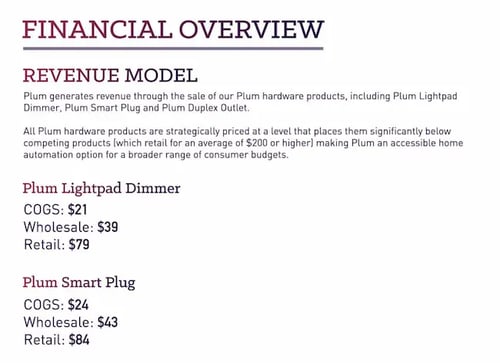
Tips for Writing Your Pricing and Revenue Section
- Get specific about your pricing strategy. Specifically, how you connect that strategy to customer needs and product value.
- If you are asking a premium price, share unique features or innovations that justify that price point.
- Show how you plan to communicate pricing to customers.
- Create an overview of every revenue stream for your business and how each stream adds to your business model as a whole.
- Share plans to develop new revenue streams in the future.
- Show how and whether pricing will vary by customer segment and how pricing aligns with marketing strategies.
- Restate your value proposition and explain how it aligns with your revenue model.
8. Financials
To me, this section is particularly informative for investors and leadership teams to figure out funding strategies, investment opportunities, and more.
According to Forbes, you’ll want to include three main things:
- Profit/Loss Statement – This answers the question of whether your business is currently profitable.
- Cash Flow Statement – This details exactly how much cash is incoming and outgoing to give insight into how much cash a business has on hand.
- Balance Sheet – This outlines assets, liabilities, and equity, which gives insight into how much a business is worth.
While some business plans might include more or less information, these are the key details I’d include in this section.
Financials Business Plan Example
This balance sheet is a great example of level of detail you’ll need to include in the financials section of your business plan.
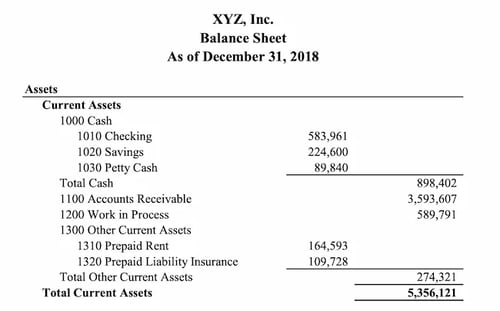
Tips for Writing Your Financials Section
- Growth potential is important in this section too. Using your data, create a forecast of financial performance in the next three to five years.
- Include any data that supports your projections to assure investors of the credibility of your proposal.
- Add a break-even analysis to show that your business plan is financially practical. This information can also help you pivot quickly as your business grows.
- Consider adding a section that reviews potential risks and how sensitive your plan is to changes in the market.
- Triple-check all financial information in your plan for accuracy.
- Show how any proposed funding needs align with your plans for growth.
As you create your business plan, keep in mind that each of these sections will be formatted differently. Some may be in paragraph format, while others could be charts or graphs.
Business Plan Types
The formats above apply to most types of business plans. That said, the format and structure of your plan will vary by your goals for that plan.
So, I’ve added a quick review of different business plan types. For a more detailed overview, check out this post.
1. Startups
Startup business plans are for proposing new business ideas.
If you’re planning to start a small business, preparing a business plan is crucial. The plan should include all the major factors of your business.
You can check out this guide for more detailed business plan inspiration.
2. Feasibility Studies
Feasibility business plans focus on that business’s product or service. Feasibility plans are sometimes added to startup business plans. They can also be a new business plan for an already thriving organization.
3. Internal Use
You can use internal business plans to share goals, strategies, or performance updates with stakeholders. In my opinion, internal business plans are useful for alignment and building support for ambitious goals.
4. Strategic Initiatives
Another business plan that’s often for sharing internally is a strategic business plan. This plan covers long-term business objectives that might not have been included in the startup business plan.
5. Business Acquisition or Repositioning
When a business is moving forward with an acquisition or repositioning, it may need extra structure and support. These types of business plans expand on a company’s acquisition or repositioning strategy.
6. Growth
Growth sometimes just happens as a business continues operations. But more often, a business needs to create a structure with specific targets to meet set goals for expansion. This business plan type can help a business focus on short-term growth goals and align resources with those goals.
Sample Business Plan Templates
Now that you know what’s included and how to format a business plan, let’s review some of my favorite templates.
1. HubSpot’s One-Page Business Plan
Download a free, editable one-page business plan template.
The business plan linked above was created here at HubSpot and is perfect for businesses of any size — no matter how many strategies we still have to develop.
Fields such as Company Description, Required Funding, and Implementation Timeline give this one-page business plan a framework for how to build your brand and what tasks to keep track of as you grow.
Then, as the business matures, you can expand on your original business plan with a new iteration of the above document.
Why I Like It
This one-page business plan is a fantastic choice for the new business owner who doesn’t have the time or resources to draft a full-blown business plan. It includes all the essential sections in an accessible, bullet-point-friendly format. That way, you can get the broad strokes down before honing in on the details.
2. HubSpot’s Downloadable Business Plan Template
We also created a business plan template for entrepreneurs.
Download a free, editable one-page business plan template.
The template is designed as a guide and checklist for starting your own business. You’ll learn what to include in each section of your business plan and how to do it.
There’s also a list for you to check off when you finish each section of your business plan.
Strong game plans help coaches win games and help businesses rocket to the top of their industries. So if you dedicate the time and effort required to write a workable and convincing business plan, you’ll boost your chances of success and even dominance in your market.
Why I Like It
This business plan kit is essential for the budding entrepreneur who needs a more extensive document to share with investors and other stakeholders.
It not only includes sections for your executive summary, product line, market analysis, marketing plan, and sales plan, but it also offers hands-on guidance for filling out those sections.
3. LiveFlow’s Financial Planning Template with built-in automation

This free template from LiveFlow aims to make it easy for businesses to create a financial plan and track their progress on a monthly basis.
The P&L Budget versus Actual format allows users to track their revenue, cost of sales, operating expenses, operating profit margin, net profit, and more.
The summary dashboard aggregates all of the data put into the financial plan sheet and will automatically update when changes are made.
Instead of wasting hours manually importing your data to your spreadsheet, LiveFlow can also help you to automatically connect your accounting and banking data directly to your spreadsheet, so your numbers are always up-to-date.
With the dashboard, you can view your runway, cash balance, burn rate, gross margins, and other metrics. Having a simple way to track everything in one place will make it easier to complete the financials section of your business plan.
Why I Like It
This is a fantastic template to track performance and alignment internally and to create a dependable process for documenting financial information across the business. It’s highly versatile and beginner-friendly.
It’s especially useful if you don’t have an accountant on the team. (I always recommend you do, but for new businesses, having one might not be possible.)
4. ThoughtCo’s Sample Business Plan
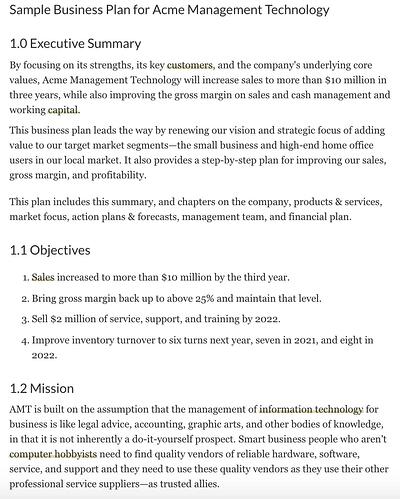
If you want to reference an actual business plan while writing your own, ThoughtCo has got you covered. It created a fictional company called Acme Management Technology and wrote an entire business plan for it.
Using its sample business plan as a guide while filling out your own will help you catch and include small yet important details in your business plan that you otherwise might not have noticed.
Why I Like It
This is a fantastic template for an existing business that’s strategically shifting directions. If your company has been around for a while, and you’re looking to improve your bottom line or revitalize your strategy, this is an excellent template to use and follow.
5. BPlan’s Free Business Plan Template

One of the more financially oriented sample business plans in this list, BPlan’s free business plan template dedicates many of its pages to your business’s financial plan and financial statements.
After filling this business plan out, your company will truly understand its financial health and the steps you need to take to maintain or improve it.
Why I Like It
I absolutely love this business plan template because of its ease-of-use and hands-on instructions (in addition to its finance-centric components). If you feel overwhelmed by the thought of writing an entire business plan, consider using this template to help you with the process.
6. Harvard Business Review’s “How to Write a Winning Business Plan”
Most sample business plans teach you what to include in your business plan, but this Harvard Business Review article will take your business plan to the next level — it teaches you the why and how behind writing a business plan.
With the guidance of Stanley Rich and Richard Gumpert, co-authors of “Business Plans That Win: Lessons From the MIT Enterprise Forum“, you’ll learn how to write a convincing business plan that emphasizes the market demand for your product or service.
You’ll also learn the financial benefits investors can reap from putting money into your venture rather than trying to sell them on how great your product or service is.
Why I Like It
This business plan guide focuses less on the individual parts of a business plan, and more on the overarching goal of writing one. For that reason, it’s one of my favorites to supplement any template you choose to use. Harvard Business Review’s guide is instrumental for both new and seasoned business owners.
7. HubSpot’s Complete Guide to Starting a Business
If you’re an entrepreneur, you know writing a business plan is one of the most challenging first steps to starting a business.
Fortunately, with HubSpot’s comprehensive guide to starting a business, you’ll learn how to map out all the details by understanding what to include in your business plan and why it’s important to include them. The guide also fleshes out an entire sample business plan for you.
If you need further guidance on starting a business, HubSpot’s guide can teach you how to make your business legal, choose and register your business name, and fund your business. It will also give small business tax information and includes marketing, sales, and service tips.
Why I Like It
This comprehensive guide will walk you through the process of starting a business, in addition to writing your business plan, with a high level of exactitude and detail. So if you’re in the midst of starting your business, this is an excellent guide for you.
It also offers other resources you might need, such as market analysis templates.
8. Panda Doc’s Free Business Plan Template
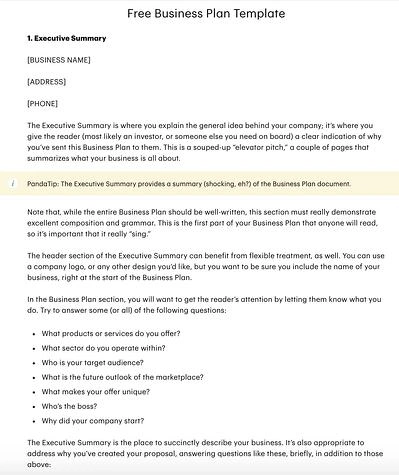
PandaDoc’s free business plan template is one of the more detailed and fleshed-out sample business plans on this list. It describes what you should include in each section, so you don’t have to come up with everything from scratch.
Once you fill it out, you’ll fully understand your business’ nitty-gritty details and how all of its moving parts should work together to contribute to its success.
Why I Like It
This template has two things I love: comprehensiveness and in-depth instructions. Plus, it’s synced with PandaDoc’s e-signature software so that you and other stakeholders can sign it with ease. For that reason, I especially love it for those starting a business with a partner or with a board of directors.
9. Small Business Administration Free Business Plan Template

The Small Business Administration (SBA) offers several free business plan templates that can be used to inspire your own plan.
Before you get started, you can decide what type of business plan you need — a traditional or lean start-up plan.
Then, you can review the format for both of those plans and view examples of what they might look like.
Why I Like It
We love both of the SBA’s templates because of their versatility. You can choose between two options and use the existing content in the templates to flesh out your own plan. Plus, if needed, you can get a free business counselor to help you along the way.
Top Business Plan Examples
I’ve compiled some completed business plan samples to help you get an idea of how to customize a plan for your business.
I chose different types of business plan ideas to expand your imagination. Some are extensive, while others are fairly simple.
Let’s take a look.
1. LiveFlow
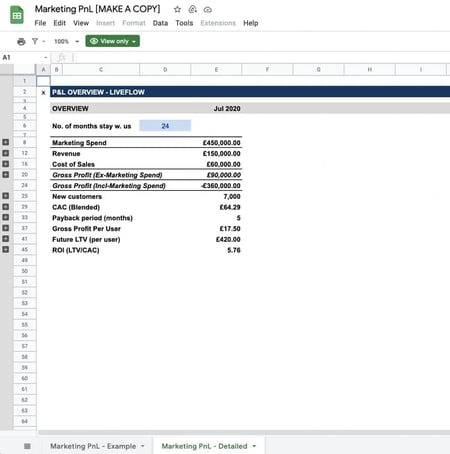
One of the major business expenses is marketing. How you handle your marketing reflects your company’s revenue.
I included this business plan to show you how you can ensure your marketing team is aligned with your overall business plan to get results. The plan also shows you how to track even the smallest metrics of your campaigns, like ROI and payback periods instead of just focusing on big metrics like gross and revenue.
Fintech startup, LiveFlow, allows users to sync real-time data from its accounting services, payment platforms, and banks into custom reports. This eliminates the task of pulling reports together manually, saving teams time and helping automate workflows.
“Using this framework over a traditional marketing plan will help you set a profitable marketing strategy taking things like CAC, LTV, Payback period, and P&L into consideration,” explains LiveFlow co-founder, Lasse Kalkar.
Why I Like It
When it came to including marketing strategy in its business plan, LiveFlow created a separate marketing profit and loss statement (P&L) to track how well the company was doing with its marketing initiatives.
This is a great approach, allowing businesses to focus on where their marketing dollars are making the most impact. Having this information handy will enable you to build out your business plan’s marketing section with confidence. LiveFlow has shared the template here. You can test it for yourself.
2. Lula Body
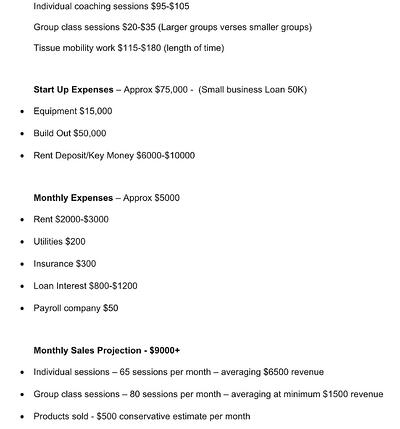
Brooklyn Business owner and Pilates instructor, Tara Kashyap, saw a need in her community for a Pilates, tissue, and bodywork studio. In response, she opened Lula Body in Crown Heights.
Pictured above is a hypothetical pricing and revenue statement based on Lula Body’s business plan. As you can see, Kashyap breaks down the cost of classes, start-up expenses, monthly expenses, and her monthly sales projection.
Everything from equipment costs to loan interest is included in the expenses to give the most accurate picture of operating costs and revenue.
If you’re seeking outside funding for your business, you’ll want to make sure this section of your business plan is as thorough as possible.
Why I Like It
This is a good business plan example for service-based businesses such as gyms, boxing classes, dancing studios, etc. For starters, the plan shows how to budget for the business loan and what to focus on buying first.
Everything is well presented, including what to charge the customers in different scenarios and the expected revenue. This is a good foundation from which business performance can be evaluated with time.
3. Patagonia
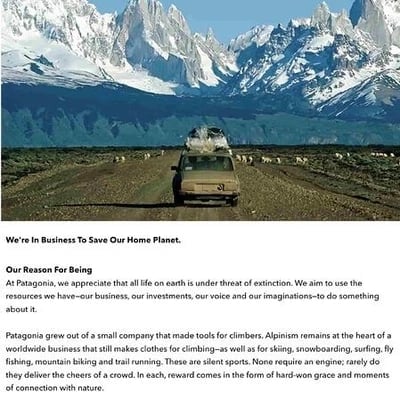
Sometimes all you need is a solid mission statement and core values to guide you on how to go about everything. You do this by creating a business plan revolving around how to fulfill your statement best.
For example, Patagonia is an eco-friendly company, so their plan discusses how to make the best environmentally friendly products without causing harm.
A good mission statement should not only resonate with consumers but should also serve as a core value compass for employees as well.
Why I Like It
Patagonia has one of the most compelling mission statements I’ve seen:
“Together, let’s prioritise purpose over profit and protect this wondrous planet, our only home.”
It reels you in from the start, and the environmentally friendly theme continues throughout the rest of the statement.
This mission goes on to explain that they are out to “Build the best product, cause no unnecessary harm, and use business to protect nature.”
Their mission statement is compelling and detailed, with each section outlining how they will accomplish their goal.
4. Vesta Home Automation
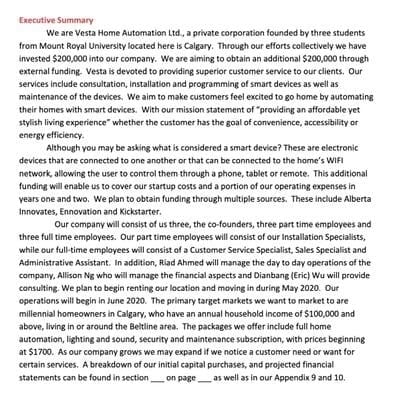
This executive summary for a smart home device startup is part of a business plan created by students at Mount Royal University.
While it lacks some of the sleek visuals of the templates above, its executive summary does a great job of demonstrating how invested they are in the business.
Right away, they mention they’ve invested $200,000 into the company already, which shows investors they have skin in the game and aren’t just looking for someone else to foot the bill.
Why I Like It
This is the kind of business plan you need when applying for business funds. It clearly illustrates the expected future of the company and how the business has been coming along over the years.
5. NALB Creative Center
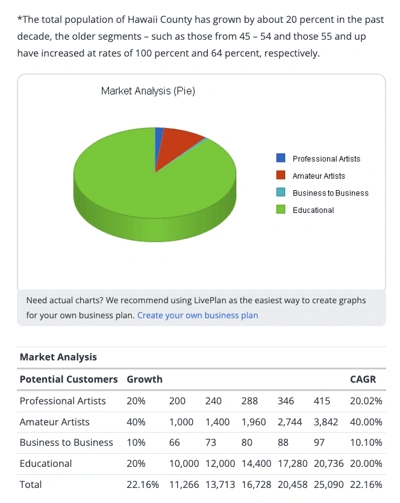
This fictional business plan for an art supply store includes everything one might need in a business plan: an executive summary, a company summary, a list of services, a market analysis summary, and more.
One of its most notable sections is its market analysis summary, which includes an overview of the population growth in the business’ target geographical area, as well as a breakdown of the types of potential customers they expect to welcome at the store.
This sort of granular insight is essential for understanding and communicating your business’s growth potential. Plus, it lays a strong foundation for creating relevant and useful buyer personas.
It’s essential to keep this information up-to-date as your market and target buyer changes. For that reason, you should carry out market research as often as possible to ensure that you’re targeting the correct audience and sharing accurate information with your investors.
Why I Like It
Due to its comprehensiveness, it’s an excellent example to follow if you’re opening a brick-and-mortar store and need to get external funding to start your business.
6. Curriculum Companion Suites (CSS)

If you’re looking for a SaaS business plan example, look no further than this business plan for a fictional educational software company called Curriculum Companion Suites.
Like the business plan for the NALB Creative Center, it includes plenty of information for prospective investors and other key stakeholders in the business.
One of the most notable features of this business plan is the executive summary, which includes an overview of the product, market, and mission.
The first two are essential for software companies because the product offering is so often at the forefront of the company’s strategy. Without that information being immediately available to investors and executives, then you risk writing an unfocused business plan.
Why I Like It
It’s essential to front-load your company’s mission if it explains your “Why?” and this example does just that. In other words, why do you do what you do, and why should stakeholders care? This is an important section to include if you feel that your mission will drive interest in the business and its offerings.
7. Culina Sample Business Plan
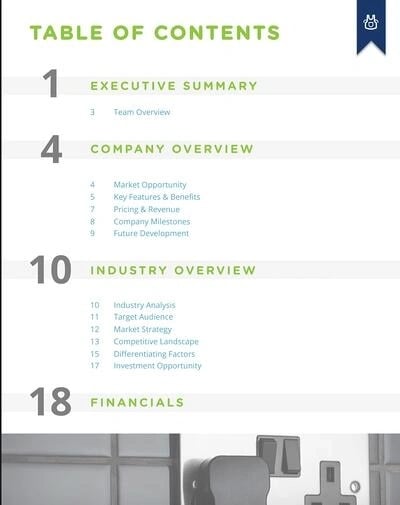
Culina’s sample business plan is an excellent example of how to lay out your business plan so that it flows naturally, engages readers, and provides the critical information investors and stakeholders need.
Why I Like It
You can use this template as a guide while you’re gathering important information for your own business plan. You’ll have a better understanding of the data and research you need to do since Culina’s plan outlines these details so flawlessly for inspiration.
8. Plum Sample Business Plan

When creating your own business plan, make sure the pictures and design you use make sense for your branding. The images in this plan are cutting-edge, which makes sense for an innovative company like Plum.
Why I Like It
This is one of my favorite sample business plans because you can see how implementing visuals can help tell your brand’s story. Additionally, the financial charts included are an excellent guide if you’re not sure what financial information to include.
9. LiveShopBuy Sample Business Plan

With this business plan, the focus is the investment opportunity. This is an excellent template to use if you’re going to use your business plan to seek funding.
Why I Like It
The investment opportunity section is placed right up front and is several pages long. Then, it goes into more detail about the company and its key services. Nice.
Get Started Writing Your Business Plan
When you’re first getting started on your business plan, I know it can be daunting. The business world moves fast, and it’s full of ambitious companies scrambling to gain the majority of their industry’s market share.
That’s why it’s important to make sure you understand the value your business offers and can communicate that through a properly formatted business plan.
Editor’s note: This post was originally published in November 2018 and has been updated for comprehensiveness. This article was written by a human, but our team uses AI in our editorial process. Check out our full disclosure to learn more about how we use AI.
MARKETING
Quiet Quitting vs. Setting Healthy Boundaries: Where’s The Line?

MARKETING
Microsoft unveils a new small language model

Phi-3-Mini is the first in a family of small language models Microsoft plans to release over the coming weeks. Phi-3-Small and Phi-3-Medium are in the works. In contrast to large language models like OpenAI’s ChatGPT and Google’s Gemini, small language models are trained on much smaller datasets and are said to be much more affordable for users.
We are excited to introduce Phi-3, a family of open AI models developed by Microsoft. Phi-3 models are the most capable and cost-effective small language models (SLMs) available, outperforming models of the same size and next size up across a variety of language, reasoning, coding and math benchmarks.
What are they for? For one thing, the reduced size of this language model may make it suitable to run locally, for example as an app on a smartphone. Something the size of ChatGPT lives in the cloud and requires an internet connection for access.
While ChatGPT is said to have over a trillion parameters, Phi-3-Mini has only 3.8 billion. Sanjeev Bora, who works with genAI in the healthcare space, writes: “The number of parameters in a model usually dictates its size and complexity. Larger models with more parameters are generally more capable but come at the cost of increased computational requirements. The choice of size often depends on the specific problem being addressed.”
Phi-3-Mini was trained on a relatively small dataset of 3.3 trillion tokens — instances of human language expressed numerically. But that’s still a lot of tokens.
Why we care. While it is generally reported, and confirmed by Microsoft, that these SLMs will be much more affordable than the big LLMs, it’s hard to find exact details on the pricing. Nevertheless, taking the promise at face-value, one can imagine a democratization of genAI, making it available to very small businesses and sole proprietors.
We need to see what these models can do in practice, but it’s plausible that use cases like writing a marketing newsletter, coming up with email subject lines or drafting social media posts just don’t require the gigantic power of a LLM.
Dig deeper: How a non-profit farmers market is leveraging AI
MARKETING
Navigating the Video Marketing Maze: Short-Form vs. Long-Form


Are you torn between using long-form or short-form videos for your small business marketing campaign? Well, you are not alone. Despite 89% of consumers wanting to see more brand videos, there is no one-size-fits-all answer about the ideal video length.
However, this should not deter you from creating an effective video strategy. In 2023, people watched an average of 17 videos per day, highlighting the influence of video content in today’s digital landscape.


Both short-form and long-form videos offer unique advantages and come with their set of challenges. Join me as I uncover the benefits and limitations of each video format to help you make informed marketing decisions.
What are Short-Form Videos?
Short videos typically range from 30 seconds to less than 10 minutes long. They are popular on social media platforms like TikTok, Instagram, Snapchat, and YouTube.
Short-form videos deliver brief yet engaging messages that quickly capture the viewer’s attention. Here are some popular types of short-form video content.
- TikTok Challenges
- Instagram Reels
- Snapchat Stories
- YouTube Shorts
- Twitter Video Ads
Benefits of Short-Form Videos
A previously cited report shows that 39% of marketers find short-form videos, ranging from 30-60 seconds long, more successful. The same study reports that 44% of customers prefer watching a short video to learn about a brand’s offerings.


So, it is evident that short-form videos have their benefits. Let’s take a closer look at some of them.
Attention-Grabbing
Short-form videos capture attention quickly, making them ideal for the fast-scrolling nature of social media platforms. Your audience is more likely to watch them in their entirety compared to longer content.
Cost-Effective Production
Creating short-form videos requires less time and resources compared to longer videos. As a small business owner with a limited budget, using short-form videos can be cost-effective.
Increased Engagement
Short-form videos engage viewers due to their crisp and concise nature. This results in more likes, comments, and shares that boost your content’s visibility and increase brand awareness.
Integrating short-form videos into your influencer marketing campaigns can further amplify your reach to new and diverse audiences.
Highly Shareable
Short videos are highly shareable. This makes it more likely for your viewers to share them, increasing their virality.


Want to get certified in Content Marketing?
Leverage the tools and channels to predictably and profitably drive awareness, leads, sales, and referrals—EVERYTHING you need to know to become a true master of digital marketing. Click Here
There are multiple benefits of adding video to your website including increased engagement, improved SEO, and enhanced user experience.
Limitations of Short-Form Videos
While short-form videos offer many advantages in content marketing, they also present some challenges.
Limited Message Depth
Due to their brief duration, short-form videos may struggle to convey complex or detailed messages. Longer videos might be more suitable if you need to communicate intricate information.
Competition for Attention
Standing out on platforms flooded with short-form video content can be challenging. You must create content that stands out to avoid becoming lost in the sea of other videos.
Shorter Lifespan
Short videos may lose their relevance with time. They can quickly get buried in users’ feeds, leading to a shorter visibility and engagement period than longer, evergreen content.
This means you must consistently create short-form videos to maintain audience interest over time.
Limited SEO Impact
Short-form videos may be more challenging to optimize for search engines than longer, more keyword-rich content. This can affect the discoverability of your content outside the social media scene.
What are Long-Form Videos?
Long-form videos are typically longer, ranging from a few minutes to several hours. They extend beyond a few minutes to several hours, providing ample time for in-depth topic exploration and detailed content.
These videos are particularly suitable for educational content, product demonstrations, and narrative-driven storytelling. Long-form videos are common on platforms like YouTube and Vimeo. Common types of long-form video content include:
- YouTube Series
- Webinars
- Educational Tutorials and Courses:
- Behind-the-Scenes Content
- Interviews and Conversations
Advantages of Long-Form Videos
Long-form video content is the fastest-growing segment, with videos above 30 minutes experiencing tremendous growth over the years. Let’s explore some of the benefits behind this growth.


Establishes Expertise and Credibility
Long-form videos allow you to provide in-depth information about various subjects, establishing your brand as an authority. Potential customers will likely trust and rely on your insights when you consistently deliver valuable content.
Builds Strong Audience Connections
The more your audience watches your videos, the more they become familiar with your content and brand. This consistent engagement promotes trust and loyalty, helping you create deeper connections with your audience.
Provide SEO Optimization Opportunities
Long-form videos keep your audience engaged for a longer duration than short ones. This signals search engines that your content provides value, resulting in higher rankings and increased visibility.
Besides, these videos provide opportunities to optimize for relevant keywords. This Attrock guide offers more insights into the value of SEO for your small business.
They Are Sustainable
Unlike short videos, well-produced and valuable long-form videos have an extended shelf life. They can continue to attract views and engagement over an extended period, contributing to a sustainable content strategy.
Instagram reels are also a part of short videos and you can get benefits from this platform by integrating it with your website. You can learn how to embed Instagram Reels on websites and get extra benefits from your Reels.
Drawbacks of Long-Form Videos
Despite their benefits, long-form videos also have certain limitations, including:
Attention Span Challenges
Between distractions, juggling tasks, and information overload, user attention span quickly diminishes. Viewers may lose interest and disengage from your long video before its conclusion.
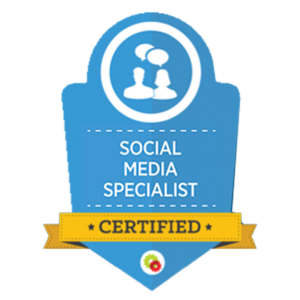

Are You Ready to Master Social Media?
Become a Certified Social Media Specialist and learn the newest strategies (by social platform) to draw organic traffic to your social media sites.
Complex Production Process
Creating high-quality long-form videos requires more resources, including time, equipment, and skilled personnel. This can be disadvantageous, especially for small businesses with limited budgets.
Platform Limitations
Some social media platforms and video hosting sites may limit video length, making it challenging to distribute long-form video content. You may then be forced to repurpose your content to suit various platforms.
Short-Form or Long-Form Videos: Which Are Better?
Now that you know the benefits and limitations of each format, which one should you choose? Short-form or long-form videos?
Well, it all boils down to considering several factors, such as:
Content Objectives
What do you want to achieve from your video marketing campaign? Short-form videos are highly effective for quick brand exposure and generating buzz. Long-form videos, on the other hand, contribute to a more in-depth understanding of the brand.
Target Audience Preferences
Audiences with short attention spans likely prefer short-form videos, while long-form videos appeal to those seeking a more immersive experience.
Similarly, short-form videos may appeal more to younger audiences, while older demographics may prefer the depth of long-form content.
Platform Dynamics
Various platforms support different content formats. Short-form videos are well-suited for platforms like TikTok, Instagram, and Snapchat. On the other hand, platforms like YouTube and Vimeo are better for hosting longer videos.
Industry Type
Short-form videos would be ideal if your industry thrives on trends, entertainment, and quick messages. However, long-form videos are effective for industries requiring in-depth explanations or educational content.
Bottom Line
Ultimately, choosing short-form or long-form videos depends on your business’s specific needs and goals. Since both formats have advantages and limitations, making a choice may prove difficult.
However, it doesn’t have to be an uphill task. The key lies in recognizing when to incorporate each video format into your marketing strategy. Understanding your audience and its needs allows you to combine both formats strategically, maximizing the benefits of each.
Continuously analyze performance metrics and adapt your video marketing strategy accordingly to ensure optimal engagement and conversion rates.
-

 MARKETING6 days ago
MARKETING6 days agoEffective Communication in Business as a Crisis Management Strategy
-

 SEARCHENGINES7 days ago
SEARCHENGINES7 days agoGoogle Won’t Change The 301 Signals For Ranking & SEO
-

 SEO6 days ago
SEO6 days agobrightonSEO Live Blog
-

 PPC7 days ago
PPC7 days ago9 Ecommerce Trends to Boost Your Business in 2024
-

 SEO4 days ago
SEO4 days agoGoogle March 2024 Core Update Officially Completed A Week Ago
-

 SEO7 days ago
SEO7 days agoHow To Write ChatGPT Prompts To Get The Best Results
-

 WORDPRESS5 days ago
WORDPRESS5 days ago9 Best WooCommerce Multi Vendor Plugins (Compared)
-
SEARCHENGINES6 days ago
Daily Search Forum Recap: April 25, 2024




















